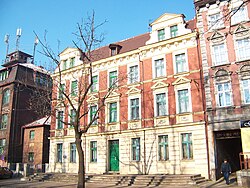Bielszowice
Bielszowice | |
|---|---|
 Old tenement houses at Główna Street in Bielszowice | |
 Location of Bielszowice within Ruda Śląska | |
| Coordinates: 50°16′07″N 18°50′03″E / 50.268508°N 18.834216°E | |
| Country | |
| Voivodeship | Silesian |
| County/City | Ruda Śląska |
| First mentioned | 1472 |
| Within city limits | 1959 |
| Time zone | UTC+1 (CET) |
| • Summer (DST) | UTC+2 (CEST) |
| Area code | (+48) 032 |
| Vehicle registration | SL, SRS |
| Primary airport | Katowice Airport |
Bielszowice (German: Bielschowitz) is a district in the west of Ruda Śląska, Silesian Voivodeship, southern Poland. In 2006 it had an area of 10.6 km2 and was inhabited by 9,505 people.[1] On January 12, 2006 a part of it was split off to form a new district, Czarny Las.
History[edit]
The settlement was first mentioned in 1452 as Bilechowitz.[2] It was a seat of a Catholic parish in Diocese of Kraków, established probably around 1440.[2] The village was annexed by Prussia in the 18th century, and from 1871 it was also part of Germany. Beginning with the 19th century it was heavily affected by industrial development. Bielszowice Coal Mine was built in years 1896–1904. In 1891 the German state purchased the village from private hands.
After World War I in the Upper Silesia plebiscite 4,546 out of 6,461 voters in Bielszowice voted in favour of rejoining Poland which just regained independence, against 1,874 opting for staying in Germany.[3] Afterwards it became a part of Silesian Voivodeship, Second Polish Republic. During the German invasion of Poland, which started World War II, the village was invaded and then occupied by Nazi Germany, and already on September 3, 1939 the Germans carried out the first execution of a local Polish man (see Nazi crimes against the Polish nation).[4] Edmund Kokot, notable local member of the Polish resistance movement, who as its secret agent joined and infiltrated the German SA, was publicly hanged by the Germans in Bielszowice in 1942.[5] There is monument at the execution site.[5] After the war, the settlement was restored to Poland.
Bielszowice constituted a gmina (municipality) that was merged into Nowy Bytom in 1951,[6] and as part of Nowy Bytom was amalgamated with Ruda to form Ruda Śląska on December 31, 1958.[7]
Notable people[edit]
- Marian Foik (1933–2005), Polish male sprinter, silver medalist of the 1964 Summer Olympics
- Waldemar Słomiany (born 1943), retired Polish footballer and member of the Poland national football team
- Wiktor Skworc (born 1948), Polish Catholic bishop
- Adam Kompała (born 1973), retired Polish footballer
Gallery[edit]
-
Saint Mary Magdalene church
-
Typical old house at Niedzieli Street
-
Monument at the site of the execution of Edmund Kokot
-
Statue of Saint John of Nepomuk
References[edit]
- ^ "Tab. 47 Rozkład dysfunkcji w mieście w latach 2003-2006". Lokalny Program Rewitalizacji Miasta Ruda Śląska na lata 2007-2015 (PDF) (in Polish). Ruda Śląska: Urząd Miasta Ruda Śląska. September 2007. p. 52. Archived from the original (PDF) on 2018-07-31. Retrieved 2015-05-12.
- ^ a b Maroń, Franciszek (1969). "Rozwój sieci parafialnej w diecezji katowickiej aż do końca XV wieku" [The development of a net of parish in Diocese of Katowice until the end of the 15th century]. Śląskie Studia Historyczno-Teologiczne (in Polish): 120–121. Archived from the original on 2019-02-28. Retrieved 2015-05-13.
- ^ "Results of the Upper Silesia plebiscite in Hindendurg/Zabrze County" (in German). Archived from the original on 2016-03-04. Retrieved 2015-05-03.
- ^ Wardzyńska, Maria (2009). Był rok 1939. Operacja niemieckiej policji bezpieczeństwa w Polsce. Intelligenzaktion (in Polish). Warszawa: IPN. p. 277.
- ^ a b "Bielszowicki bohater". rudaslaska.pl (in Polish). Retrieved 9 May 2021.
- ^ Rozporządzenie Rady Ministrów z dnia 17 marca 1951 r. w sprawie zniesienia i zmiany granic niektórych powiatów oraz utworzenia i zmiany granic niektórych miast, stanowiących powiaty miejskie w województwie katowickim., Dz. U. z 1951 r. Nr 18, poz. 147
- ^ Rozporządzenie Rady Ministrów z dnia 18 listopada 1958 r. w sprawie utworzenia miasta Ruda Śląska stanowiącego powiat miejski w województwie katowickim., Dz. U. z 1958 r. Nr 69, poz. 342




